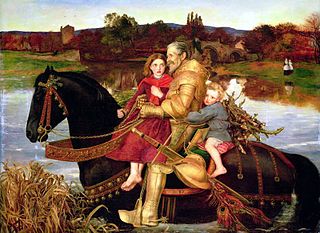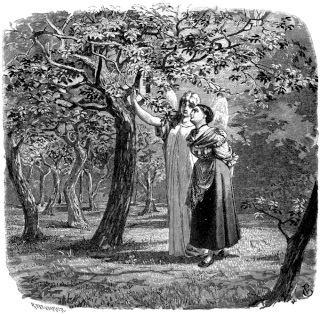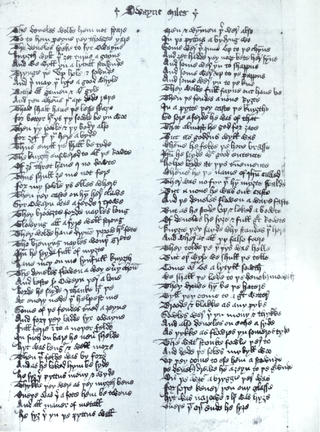Related Research Articles
According to the medieval poet Jean Bodel, the Matter of Rome is the literary cycle of Greek and Roman mythology, together with episodes from the history of classical antiquity, focusing on military heroes like Alexander the Great and Julius Caesar. Bodel's division of literary cycles also included the Matter of France and the Matter of Britain. The Matter of Rome includes the Matter of Troy, consisting of romances and other texts based on the Trojan War and its legacy, including the adventures of Aeneas.

"The Man of Law's Tale" is the fifth of the Canterbury Tales by Geoffrey Chaucer, written around 1387. John Gower's "Tale of Constance" in Confessio Amantis tells the same story and may have been a source for Chaucer. Nicholas Trivet's Les chronicles was a source for both authors.
"The Wife's Lament" or "The Wife's Complaint" is an Old English poem of 53 lines found on folio 115 of the Exeter Book and generally treated as an elegy in the manner of the German frauenlied, or "women's song". The poem has been relatively well preserved and requires few if any emendations to enable an initial reading. Thematically, the poem is primarily concerned with the evocation of the grief of the female speaker and with the representation of her state of despair. The tribulations she suffers leading to her state of lamentation, however, are cryptically described and have been subject to many interpretations. Indeed, Professor Stephen Ramsay has said, "the 'correct' interpretation of "The Wife's Lament" is one of the more hotly debated subjects in medieval studies."
Gesta Romanorum is a Latin collection of anecdotes and tales that was probably compiled about the end of the 13th century or the beginning of the 14th. It still possesses a two-fold literary interest, first as one of the most popular books of the time, and secondly as the source, directly or indirectly, of later literature, in Geoffrey Chaucer, John Gower, Giovanni Boccaccio, Thomas Hoccleve, William Shakespeare, and others.

As a literary genre, the chivalric romance is a type of prose and verse narrative that was popular in the noble courts of high medieval and early modern Europe. They were fantastic stories about marvel-filled adventures, often of a chivalric knight-errant portrayed as having heroic qualities, who goes on a quest. It developed further from the epics as time went on; in particular, "the emphasis on love and courtly manners distinguishes it from the chanson de geste and other kinds of epic, in which masculine military heroism predominates."

The story of the Knight of the Swan, or Swan Knight, is a medieval tale about a mysterious rescuer who comes in a swan-drawn boat to defend a damsel, his only condition being that he must never be asked his name.

Sir Isumbras is a medieval metrical romance written in Middle English and found in no fewer than nine manuscripts dating to the fifteenth century. This popular romance must have been circulating in England before 1320, because William of Nassyngton, in his work Speculum Vitae, which dates from this time, mentions feats of arms and other 'vanities', such as those found in stories of Sir Guy of Warwick, Bevis of Hampton, Octavian and Sir Isumbras. Unlike the other three stories, the Middle English Sir Isumbras is not a translation of an Old French original.

Genevieveof Brabant is a heroine of medieval legend. The story is told in the "Golden Legend" and concerns a virtuous wife falsely accused of infidelity.

"Allerleirauh" is a fairy tale recorded by the Brothers Grimm. Since the second edition published in 1819, it has been recorded as Tale no. 65. Andrew Lang included it in The Green Fairy Book.

"The Girl Without Hands" or "The helpless Maiden" or "The Armless Maiden" is a German fairy tale collected by the Brothers Grimm. It is tale number 31 and was first published in the 1812 edition of Children's and Household Tales. The story was revised by the Grimm brothers over the years, and the final version was published in the 7th edition of Children's and Household Tales in 1857. It is Aarne-Thompson type 706.

The Vitae duorum Offarum "The lives of the two Offas" is a literary history written in the mid-thirteenth century, apparently by the St Albans monk Matthew Paris; however, the most recent editor and translator of the work rejects this attribution and argues for an earlier date, in the late twelfth century. The earliest editor, William Wats, argues that the texts are older than Matthew's day but were revised by him; he bases this view on stylistic elements, such as the inclusion in the first Vita of a quotation from Lucan which also appears repeatedly in Matthew's Chronica maiora.
Emaré is a Middle English Breton lai, a form of mediaeval romance poem, told in 1035 lines. The author of Emaré is unknown and it exists in only one manuscript, Cotton Caligula A. ii, which contains ten metrical narratives. Emaré seems to date from the late fourteenth century, possibly written in the North East Midlands. The iambic pattern is rather rough.

Octavian is a 14th-century Middle English verse translation and abridgement of a mid-13th century Old French romance of the same name. This Middle English version exists in three manuscript copies and in two separate compositions, one of which may have been written by the 14th-century poet Thomas Chestre who also composed Libeaus Desconus and Sir Launfal. The other two copies are not by Chestre and preserve a version of the poem in regular twelve-line tail rhyme stanzas, a verse structure that was popular in the 14th century in England. Both poetic compositions condense the Old French romance to about 1800 lines, a third of its original length, and relate “incidents and motifs common in legend, romance and chanson de geste.” The story describes a trauma that unfolds in the household of Octavian, later the Roman Emperor Augustus, whose own mother deceives him into sending his wife and his two newborn sons into exile and likely death. After many adventures, the family are at last reunited and the guilty mother is appropriately punished.

Sir Gowther is a relatively short Middle English tail-rhyme romance in twelve-line stanzas, found in two manuscripts, each dating to the mid- or late-fifteenth century. The poem tells a story that has been variously defined as a secular hagiography, a Breton lai and a romance, and perhaps "complies to a variety of possibilities". An adaptation of the story of Robert the Devil, the story follows the fortunes of Sir Gowther from birth to death, from his childhood as the son of a fiend, his wicked early life, through contrition and a penance imposed by the Pope involving him in a lowly and humiliating position in society, and to his eventual rise, via divine miracles, as a martial hero and ultimately to virtual canonization. But despite this saintly end, "like many other lays and romances, Sir Gowther derives much of its inspiration from a rich and vastly underappreciated folk tradition."

Sir Eglamour of Artois is a Middle English verse romance that was written sometime around 1350. It is a narrative poem of about 1300 lines, a tail-rhyme romance that was quite popular in its day, judging from the number of copies that have survived – four manuscripts from the 15th century or earlier and a manuscript and five printed editions from the 16th century. The poem tells a story that is constructed from a large number of elements found in other medieval romances. Modern scholarly opinion has been critical of it because of this, describing it as unimaginative and of poor quality. Medieval romance as a genre, however, concerns the reworking of "the archetypal images of romance" and if this poem is viewed from a 15th-century perspective as well as from a modern standpoint – and it was obviously once very popular, even being adapted into a play in 1444 – one might find a "romance [that] is carefully structured, the action highly unified, the narration lively."
Le Bone Florence of Rome is a medieval English chivalric romance. Featuring the innocent persecuted heroine, it is subcategorized into the Crescentia cycle of romances because of two common traits: the heroine is accused by her brother-in-law after an attempted seduction, and the story ends with her fame as a healer bringing all her persecutors to her.
The Erl of Toulouse is a Middle English chivalric romance centered on an innocent persecuted wife. It claims to be a translation of a French lai, but the original lai is lost. It is thought to date from the late 14th century, and survives in four manuscripts of the 15th and 16th centuries. The Erl of Toulouse is written in a north-east Midlands dialect of Middle English.
The King of Tars is a medieval English chivalric romance, an amplified version of the oldest variant found in the Reimchronik, which is found in three manuscripts including the Auchinleck manuscript. It dates from c. 1330, or perhaps earlier. It contains many specific religious phrases, and is consistently religious in intent. In addition, The King of Tars exhibits attributes of other genres typical of the medieval period, including hagiography, political drama, and miracle tale.
Margaret Schlauch was a scholar of medieval studies at New York University and later, after she left the United States for political reasons in 1951, at the University of Warsaw, where she headed the departments of English and General Linguistics. Her work covered many topics but included focuses on Chaucer, Anglo-Saxon, and Old Norse literature.
The Calumniated Wife is a motif in traditional narratives, numbered K2110.1 in Stith Thompson's Motif-Index of Folk-Literature. It entails a wife being falsely accused of, and often punished for, some crime or sin. This motif is at the centre of a number of traditional plots, being associated with tale-types 705–712 in the Aarne–Thompson–Uther Index of tale-types.
References
- 1 2 3 4 Laura A. Hibbard, Medieval Romance in England p. 12 New York Burt Franklin,1963
- 1 2 Carol Falvo Heffernan, Le Bone Florence of Rome, p 3 ISBN 0-7190-0647-3, OCLC 422642874
- ↑ Margaret Schlauch, Chaucer's Constance and Accused Queens, New York: Gordian Press 1969 p. 111
- ↑ Laura A. Hibbard, Medieval Romance in England p. 12-13 New York Burt Franklin,1963
- ↑ Margaret Schlauch, Chaucer's Constance and Accused Queens, New York: Gordian Press 1969 p 95
- ↑ Carol Falvo Heffernan, Le Bone Florence of Rome, p 9-10, ISBN 0-7190-0647-3, OCLC 422642874
- ↑ Laura A. Hibbard, Medieval Romance in England p23 New York Burt Franklin,1963
- ↑ John Simons, "Northern Octavian and the Question of Class," in Romance in Medieval England. Ed. Maldwyn Mills, Jennifer Fellows, and Carol M. Meale. Cambridge: D. S. Brewer, 1991, 108-09.
- ↑ "OCTAVIAN: NOTES Archived 2012-08-04 at archive.today "
- ↑ Margaret Schlauch, Chaucer's Constance and Accused Queens, New York: Gordian Press 1969 p. 75
- ↑ Aarne, A. (1961). The Types of the Folk-tale: A Classification and Bibliography. Bibliography and Reference Series. B. Franklin. pp. 247–248. ISBN 978-0-8337-4489-0 . Retrieved 7 December 2020.